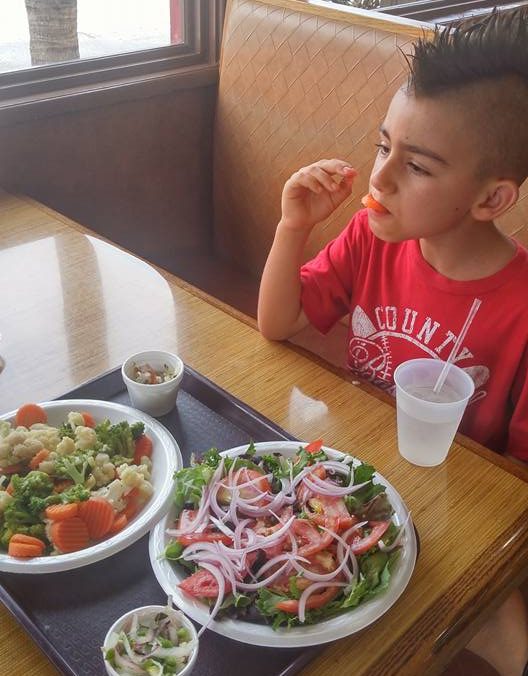Want to improve what your children are eating?
Right from the start, nutrition shapes brain development, metabolism, and overall health. If you look around, you realize how unhealthy today’s kids are. And why wouldn’t they be? They are in the midst of a war…..a war over their minds and taste buds to win brand loyalty for life. Companies know to hook children early if they want the big bucks…and these companies not only market ingeniously, but also use the latest in technological advancements for engineering highly palatable foods.
Food companies spend $10 billion annually on marketing to kids.
Need a reminder of WHY eating healthy is such an important thing for kids these days? Research shows that overweight kids are particularly affected by food branding.
“Consuming Kids” Trailer
We have managed to make everything super-duper fatty, sugary and attractive so that our kids will instantly become addicted to them. Have you seen what Burger King has done to Cheetos (deep friend mac-n-cheese in cheetos dust)…seriously….seriously….is this what we have come to?

Just take a look at these facts…
(from Precision Nutrition)
- 70% of obese teens are already showing signs of cardiovascular disease— a health problem that normally doesn’t appear until decades later.
- Adipose tissue (fat) secretes hormones and chemical signals; too much fat means inflammation. In kids, this means things like asthma.
- Fat can accumulate in the liver; non-alcoholic fatty liver disease(NAFLD) is the leading cause of liver disease in kids worldwide. Children with fatty livers face double the risk of arterial plaque buildup.
- Over-fat children have impaired insulin sensitivity, glucose disposal, and prediabetes.
- Over-fat children have higher long-term risk of chronic conditions such as stroke; breast, colon, and kidney cancers; musculoskeletal disorders; and gall bladder disease.
- Normal growth and hormonal development can be disrupted. This can affect how they develop during puberty, and their future reproductive health. Girls might hit puberty way too early; boys may experience gynecomastia (breast development).
Once a body is overweight at a critical developmental period, it’s very hard to change. Health and physical activity habits established in early life will have effects for decades to come.
3 Things You Can Do NOW
#1 Reduce sugar as much as possible and focus on mostly whole foods
Now if you’ve been following me for very long you know that I’m not completely against sugar and know that you can have some in moderation without any issues. However, for kids this is BIG problem most of the time because they don’t know what moderation is.
Now you might be thinking “My kids/grandkids are fine because they don’t drink soft drinks and rarely have sugary desserts”. That’s great, but keep in mind most kid breakfast cereals and kid friendly yogurt (Go-Gurt) contain ounce-for-ounce about the same amount of sugar.

Focus on whole foods such as:
– Whole eggs
– Healthy meats and fish and shellfish
– Nuts and seeds for snacks
– Full-fat dairy
These types of foods (and we’ll get to fruits and veggies in a minute) will allow your child to get all the quality fats, carbs, proteins, vitamins, minerals, and nutrients they actually need from food.
#2 Incorporate fruits and vegetables

Problem: Kids don’t like the taste of vegetables.
Solution: Prepare vegetables differently. Try roasting, making into a soup, sneaking veggies into a shake with fruit, or serving them raw. And remember, it might require ten or more exposures before a child embraces a new food. So give it time. Keep trying new options. And keep looking for ways to incorporate veggies into meals.
Problem: Preparation seems inconvenient or difficult.
Solution: Keep prepared vegetables such as pre-washed baby veggies handy. Involve children in vegetable and fruit prep — even young children can do things like snap the ends off green beans, mash avocados, or tear up lettuce for salad. The more involved children are, the more likely they are to try new foods
. 
Problem: No access
Solution: Keep vegetables at home and at school. Rearrange the fridge to make prepared vegetables accessible and less healthy alternatives harder to reach.
Problem: Fruits and vegetables aren’t cool because they don’t have their own commercial.
Solution: Don’t rely on advertising to make food choices. Teach kids to be media-savvy. Help them understand that advertising is designed to sell stuff – not necessarily with their well-being in mind. And take them shopping with you. Let them explore the produce section and choose some things they’d like to try.
Problem: Peer pressure to eat non-nutritious foods
Solution: What happens around peers stays around peers. Focus on eating better at home and teaching your kids the “why’s” of what they are doing, so they can make their own informed choices around peers.
Problem: Parents aren’t eating veggies.
Solution: Parents eat veggies. You knew I was going to say that, right?
And that leads me to the most important tip I can give you….
#3 Take the lead yourself
It doesn’t matter how much you implement the first 2 tips.
It’s all pretty much worthless if you don’t lead by example.
You’re in charge here.
It’s your job to provide the food. But it’s the child’s choice whether to eat it. When kids are hungry, they’ll eat.
Set a good example of healthy eating yourself.
Ultimately, children will nearly always pay more attention to what their parents do than what their parents say. So set a great example, and chances are, your children will follow where your lead 🙂
*BONUS*
While I know you may agree or disagree with a few things I’ve outlined you’re still probably thinking “but what about having SOME treats, should they always be off limits?”
The answer to this question is not at all. However it’s just like I tell all of our members at Palm Beach Fit Body Boot Camp and Train with Jodi, make “treats” just that…..a true treat and have them only occasionally and 90% of the time outside of the house.
Because guess what? When you go OUT for ice cream, you get to leave the ice cream at the ice cream place. When you bring it home, you and/or your kids end up having it several nights a week.
I hope these tips gave you some new strategies, more education, and hopefully more confidence that this CAN be done with your kids. But again, just like we tell our members…..take it one step at a time. Pick one thing to change and work on that for 1-2 weeks before trying to change anything else.
My kids love healthy food because they have grown up on it. It is possible, start NOW :).





